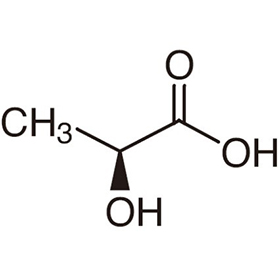
With a hydroxyl group adjacent to the carboxyl group, lactic acid is classified as an alpha-hydroxy acid (AHA). AHAs are frequently used in skincare products because they have the ability to exfoliate the skin, stimulate the skin’s natural regeneration process, and help the skin to retain moisture.
Lactic acid naturally occurs in fermented foods but can also be synthetic and added to packaged foods. Some common foods that contain lactic acid are sauerkraut, yogurt, milk, sourdough bread, tomato and salami.
Lactic Acid & Sodium Lactate
As an exfoliator, here are some of the primary benefits of lactic acid for the skin:
FADES MILD HYPERPIGMENTATION
Lactic acid exfoliates the skin surface by breaking down the adhesion junction that holds dead skin cells together. Therefore, it fades mild hyperpigmentation like dark spots, age spots, freckles and acne scars that result in uneven skin tone.
Moreover, lactic acid directly inhibits tyrosinase activity which is the key enzyme involved in the synthesis of melanin that gives skin color and contributes to the formation of undesirable dark spots. Therefore, by inhibiting tyrosinase, lactic acid may be able to reduce abnormal pigmentation associated with aging and exposure to UV light.
BOOSTS SKIN HYDRATION
Lactic acid is the key element of the skin’s Natural Moisturizing Factor (NMF). It maintains adequate skin hydration by attracting and retaining moisture in the skin by functioning as a humectant. Lactic acid also stimulates ceramide synthesis to prevent trans-epidermal water loss and promote healthy, intact and moisturized skin.
By improving the skin's natural hydration, lactic acid prevents dry skin and helps to keep the skin moisturized while also smoothing away any skin texture imperfections. This is crucial for anyone with sensitive skin or other related conditions such as psoriasis or eczema.
FIGHTS ACNE
Lactic acid is keratolytic, meaning it sloughs away the dead skin cells that can clog pores and cause acne breakouts. In addition, its moisturizing effects keep the skin hydrated and soft, allowing blemishes to heal better.
REDUCES FINE LINES AND WRINKLES
Lactic acid diminishes the appearance of fine lines and wrinkles by deeply exfoliating the top layer of skin. Therefore, it accelerates the skin cell renewal, which increases the production of collagen and ceramide while maintaining the proper hydration of newly exfoliated skin. The combination of refreshed skin cells and better-hydrated skin is both the key to reducing existing fine lines and wrinkles as well as preventing new ones from forming.
STRENGTHENS LIPID LAYER
Lactic acid exfoliation stimulates skin cell regeneration, and during skin cell regeneration, the lipids between your skin cells renew. This is important because lipids are the healthy, fatty, ceramides that make up the skin's barrier function. As a result, lactic acid stimulates ceramide production, which leads to a stronger lipid layer that improves the skin's natural ability to retain hydration (a crucial part of preventing fine lines and wrinkles).
Lactic acid is safe to use in cosmetic products with concentrates specified in this safety assessment.
https://online.personalcarecouncil.org/ctfa-static/online/lists/cir-pdfs/pr34.pdf
https://www.ncbi.nlm.nih.gov/pmc/articles/PMC6017965/
https://www.ncbi.nlm.nih.gov/pmc/articles/PMC4277239/
https://pubmed.ncbi.nlm.nih.gov/30270529/
https://www.ncbi.nlm.nih.gov/pmc/articles/PMC3047947/
https://pubmed.ncbi.nlm.nih.gov/11453900/
https://www.ncbi.nlm.nih.gov/pmc/articles/PMC3900339/